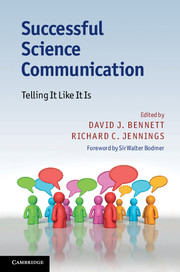Book contents
- Frontmatter
- Contents
- Foreword
- Authors' biographies
- Introduction Public engagement in an evolving science policy landscape
- Part I What it helps to know beforehand
- 1 Deficits and dialogues: science communication and the public understanding of science in the UK
- 2 Explaining the world: communicating science through the ages
- 3 Science: truth and ethics
- 4 The public's view of science
- 5 The common language of research
- 6 Not 100% sure? The ‘public’ understanding of risk
- 7 The ethos of science vs. ethics of science communication: on deficit and surplus models of science–society interaction
- Part II Policy-makers, the media and public interest organisations
- Part III What you can do and how to do it
- Part IV And finally, evaluating and embedding science communication
- Index
- Plate section
- References
4 - The public's view of science
Published online by Cambridge University Press: 05 May 2013
- Frontmatter
- Contents
- Foreword
- Authors' biographies
- Introduction Public engagement in an evolving science policy landscape
- Part I What it helps to know beforehand
- 1 Deficits and dialogues: science communication and the public understanding of science in the UK
- 2 Explaining the world: communicating science through the ages
- 3 Science: truth and ethics
- 4 The public's view of science
- 5 The common language of research
- 6 Not 100% sure? The ‘public’ understanding of risk
- 7 The ethos of science vs. ethics of science communication: on deficit and surplus models of science–society interaction
- Part II Policy-makers, the media and public interest organisations
- Part III What you can do and how to do it
- Part IV And finally, evaluating and embedding science communication
- Index
- Plate section
- References
Summary
Why take the public seriously?
The focus in this chapter is on public perceptions of science, taking biotechnology and the life sciences as an exemplar. From almost its outset in 1974, with the application to patent recombinant DNA, biotechnology has been understood as having far-reaching implications for the lives of us all. In 1975, scientists agreed at the Asilomar Conference in California to a voluntary moratorium on their research, such was the scale of their concern about the potential and unknown health and safety issues associated with this new technology. But the economic benefits of biotechnology soon became its focal point, and the moratorium was soon lifted. In 1979 a European Community report entitled The Biosociety described biotechnology as central to economic competitiveness in subsequent years. But even at that time, the European public was uneasy and troubled by the idea of gene technology. As Mark Cantley, then a senior member of the European Commission, wrote, ‘what the sector ignored above all was public perception . . . the public were learning to see gene technology, genetic engineering, biotechnology and so on as a single, vague and disquieting phenomenon’ (Cantley 1992). A Eurobarometer survey in 1979 found that 49 per cent of the European public saw genetic research as an unacceptable risk and a similar percentage thought the same about ‘synthetic food’, or what we now call GM food (Gaskell 2004).
However, the early warning signals from the public went unheeded. In the 1990s, the life sciences project, embracing medical, pharmaceutical, industrial and agri-food technologies based on recombinant DNA, took off led by European and North American multinational companies. They based their strategy on the market model of innovation, depicted in Figure 4.1 (Gaskell 2008). Here success in the process of innovation is contingent on gaining the support of the regulators and the market forces.
Information
- Type
- Chapter
- Information
- Successful Science CommunicationTelling It Like It Is, pp. 60 - 76Publisher: Cambridge University PressPrint publication year: 2011
